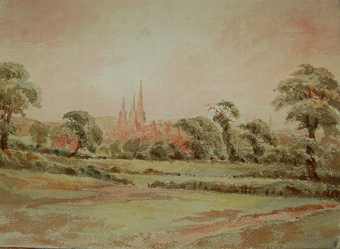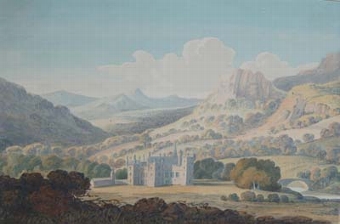featured item
the falls of the clyde
- View other items in:
- antiques interior design modern and vintage
- other interior design
artware ltd
Enquire about this antique
Artware Ltd has 565 antiques for sale.
click here to see them all
The Falls of Clyde is the collective name of four linn (Scots: waterfalls) on the River Clyde near New Lanark, South Lanarkshire, Scotland. The Falls of Clyde comprise the upper falls of Bonnington Linn, Corra Linn, Dundaff Linn, and the lower falls of Stonebyres Linn. Corra Linn is the highest, with a fall of 90 feet. Bonnington Linn (fall of 30 feet), Corra Linn and Dundaff Linn are above New Lanark and located within the Falls of Clyde Reserve managed by the Scottish Wildlife Trust, a national nature conservation charity. Stonebyres Linn is located several miles downstream from the reserve and New Lanark. The area has long been a popular destination for visitors. The Wordsworths, Coleridge and Sir Walter Scott all visited the Falls. In 1802, William Wordsworth immortalised Corra Linn, the largest of the waterfalls, in verse. Corra Linn has also been painted by a number of artists, including J. M. W. Turner.
Near Corra Linn is the Pavilion, built by Sir John Carmichael of Bonnington, probably in 1708. The Pavilion had mirrors on its back wall, and when the doors were opened visitors had the illusion of standing beneath the falls. The 15th century Corra Castle is next to Corra Linn. It is now home to a family of rare bats. Corehouse, built in 1844, the home of the Cranstoun family, is nearby. The interpretation board at the Falls of Clyde (waterfalls) viewpoint records that J. M. W. Turner, Sir Walter Scott, Samuel Taylor Coleridge and his friend William Wordsworth all visited. Turner produced a painting of the falls and Wordworth immortalised Corra Linn in verse in 1802. We cannot be sure that they visited the pavilion, but it is not unlikely, given the presence of a guide at Bonnington House lodge. The Oxford educated cleric Rev. William Gilpin (1724-1804), a schoolmaster in Surrey, toured Britain and visited the Falls of Clyde. He built an enormously influential theory on this convergence of travel and artistic recreation. John Stoddart relates that when he visited in 1799 - 1800 the mansion house of Bonnyton (Bonnington) was the seat of Lady Ross. He commends her for permitting unrestricted access to the falls and states that a porter was based at the Bonnyton Lodge house who would escorted visitor to the best viewing points and to the ''summer-house'' as he calls it. Most frustratingly he did not wish to be ''restrained'' and failed to visit the actual pavilion itself. The Bonnington Pavilion or Hall of Mirrors, now a ruin, situated in the grounds of the old estate of Bonnington, near New Lanark, overlooking Corra Linn falls on the River Clyde in Lanarkshire, Scotland. Alternative names are the Corra Linn Pavilion and the Falls of Clyde summerhouse. The building is dated 1708 over the entrance and was constructed by Sir James Carmichael of Bonnington House for the entertainment of his friends and guests. The building had mirrors installed which gave a view of the Falls of Clyde. A view of Corra Linn in 1799 ? 1800 taken from Stoddarts Remarks on Scottish scenery gives some idea of the view that visitors would have seen in the 18th-century. At the time of the construction of the pavilion it was generally felt amongst the aristocracy that nature was cruel and ugly and that women of good breeding should not look upon it unless it was reflected in a mirror or seen through a frame, thereby detaching the view from the aspect of harsh reality and transferring it to that of good taste and high art.
The building was still in use in the early 19th century, although Stoddart refers to it as a summerhouse. Garnett on his 1800 tour refers to the building as a ''pavilion'' and mentions the mirrors, saying that .. as at Dunkeld, mirrors are placed, by the reflection of which we had different views of the water. He also comments on the fine view of the cotton mills that was to be had from the west window. It is not clear when it was abandoned. The New Lanark Trust are trying to secure an agreement from Scottish Power to allow them to restore the building. The pavilion had 2 floors, and the bottom floor may have been used at one stage as a kitchen for the preparation of refreshments for the ladies and gentlemen who came down from Bonnington House to view the falls. A relatively large window, probably originally having shutters either side, looks onto the falls. The entrance door has a window set on each side, which would have prevented the projection of an image onto mirrors placed onto this ''back'' wall. A window and ground floor door were present in each of the two side walls of the building; providing up to three doors altogether into the ground floor and a total of five windows, providing for exceptionally good views out of the building. The only apparently uninterrupted surface was the upper ceiling. The artist Alexander Archer sketched the pavilion, probably including some ''artistic licence'' from the south-west in 1837. This sketch shows a different arrangement of the steps leading up to the door and a stone gable end, with highly ornate ''crow step'' ornamentation, which would have given the building a typical arched sloping roof rather than a flat one as suggested by the remains today (2007). It may well be that the changes to the entrance steps took place when the hydroelectric power station was constructed in 1926 as the pipes carrying the water to the turbine house run very close to the pavilion entrance and they had to be moved to run parallel to the front of the building.
The building shows signs of other alterations, such as the closing up of one of the lower ground front ''servants'' entrance to the suggested kitchen area and the provision of a balustrade at the viewing window, suggesting that at a later date the method of use of the building changed. Some modern repairs have been carried out to stabilise the building as indicated by recent pointing work, new wood lintels, etc. The pavilion had mirrors which reflected the falls, giving visitors, who sat with their backs to the window, the illusion, once the shutters or ''doors'' were thrown open, that they were standing in the middle of the waterfalls.The Pavilion, according to another report had mirrors on its back wall. When the doors were opened visitors supposedly had the illusion of standing beneath the falls. Swan records that A beautiful though more distant view of this extraordinary scene, may be had from the window of a pavilion, erected by Sir James Carmichael of Bonniton, placed far above, on the very summit of the sloping bank which rises from the perpendicular rocks, can contemplate the whole freed from those feelings of terror with which in nearer situations, he cannot fail to be visited. Indeed, the scene has here more of the effect of a picture, or a beautiful panoramic view; the trees through which it is seen adding their interest to the foreground, or forming as it were a framework at the sides. At the opposite end of the pavilion, a Mirror is placed, in which this rich landscape is reflected; and from its position, the spectator is almost led to believe that the cataract is tumbling upon his head. Unfortunately, however, the illusion is not made so perfect as it might obviously be. The Mirror is neither of sufficient size, of a proper shape, or sufficiently concealed in the wall. Were a little expense laid out on the pavilion, which appears to be exactly as it was left by Sir John, a hundred and twenty years ago, the illusion might be exceedingly striking.
Antiques.co.uk Ref: JXBRXPJH
- Materials:
- Oil on Canvas
- Width (cm):
- 45.72 x 35.56 cm 18.00 x 14.00 ins
Artware Ltd
Artware Fine Art specialises in fine antique, decorative and historical portraits and topographical pictures . We cover a period from the 17th and 18th centuries through to the 19th & 20th Centuries. We have over 150 portraits in stock, which can be viewed on our web site, each historical portrait has well researched biographical information both on the sitter and the artist.
Contact details
18 La gare
51 Surrey row
London
Greater London
SE1 0BZ
UNITED KINGDOM
T: 0207 921 97904
E: greg@artwarefineart.com
W: www.artwarefineart.com














